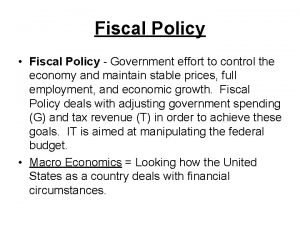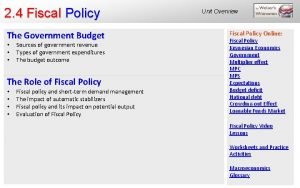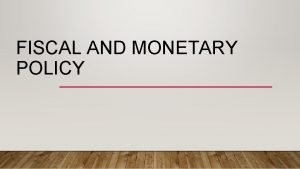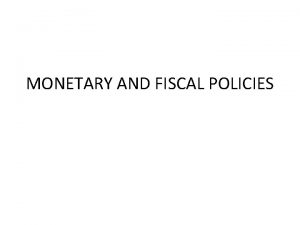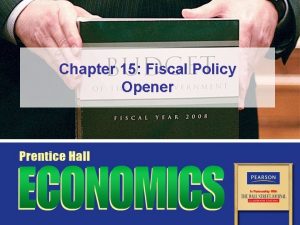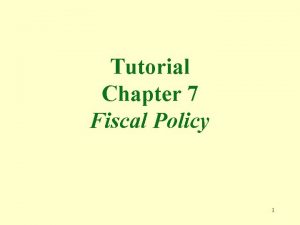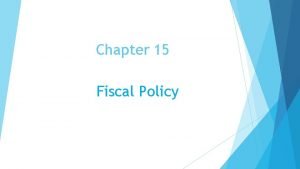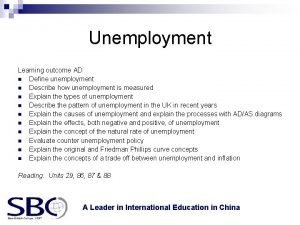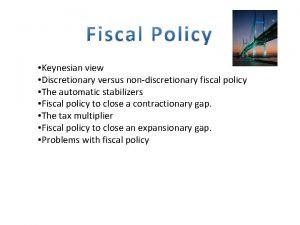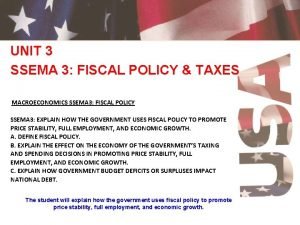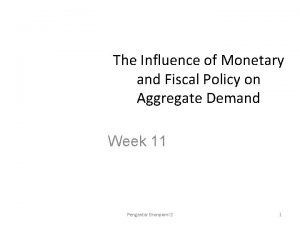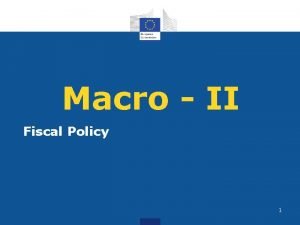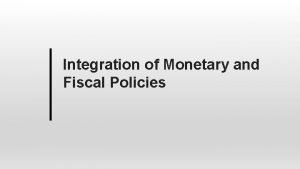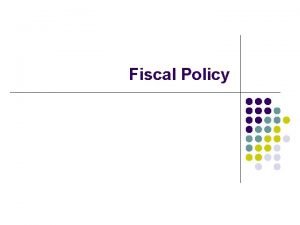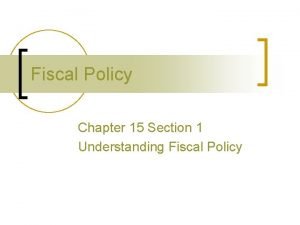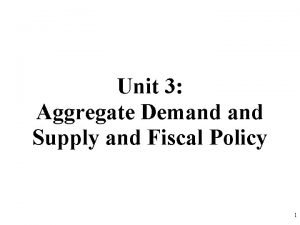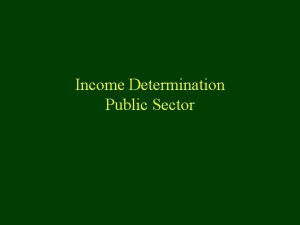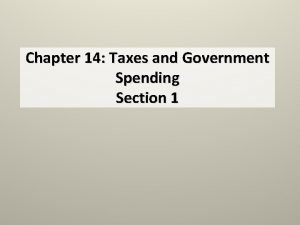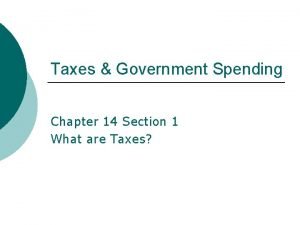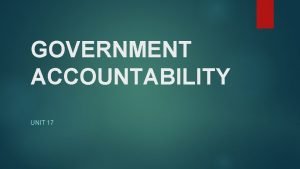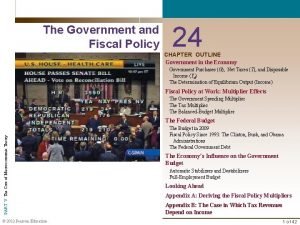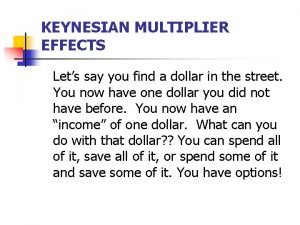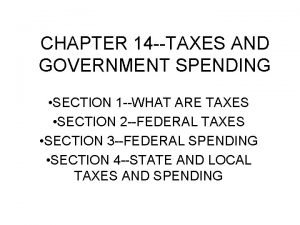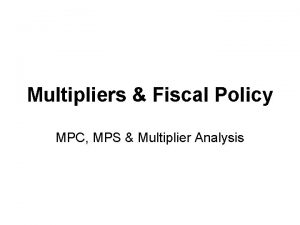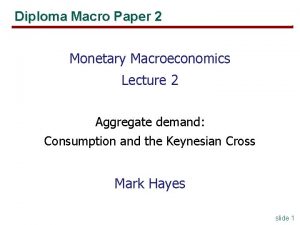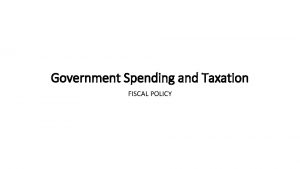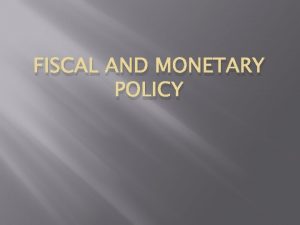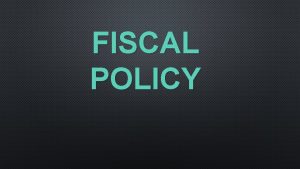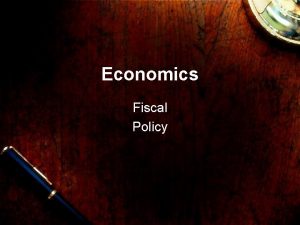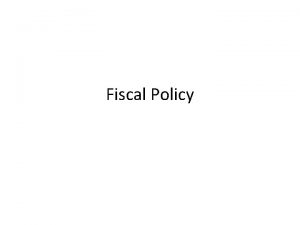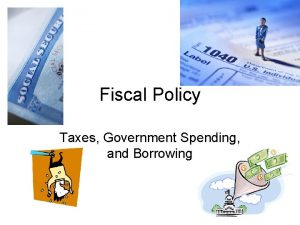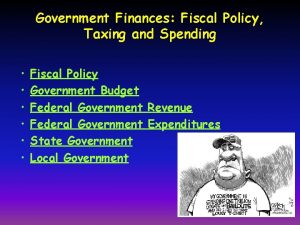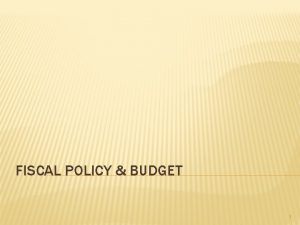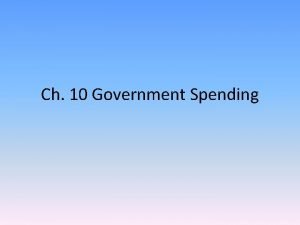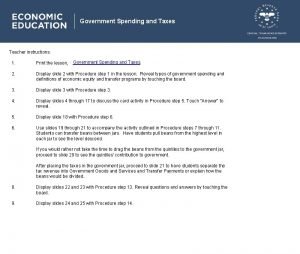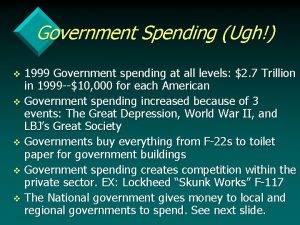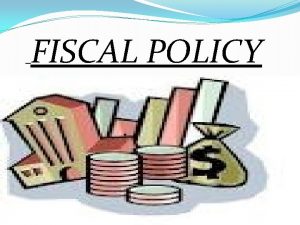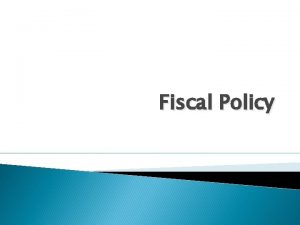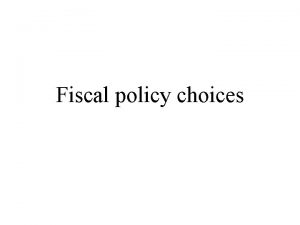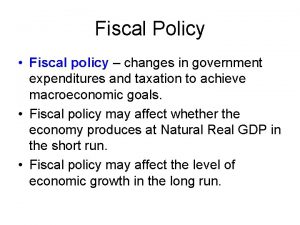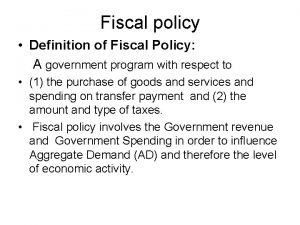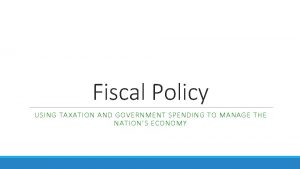29 Fiscal Policy Previously Government outlays government spending






























![Crowding Out: Example • [G] increases by $100 billion – This money is borrowed, Crowding Out: Example • [G] increases by $100 billion – This money is borrowed,](https://slidetodoc.com/presentation_image_h/04766a3d859f17ab18e3334faf9f1fd7/image-31.jpg)












- Slides: 43

29 Fiscal Policy

Previously • Government outlays = government spending + transfer payments – Government revenues = taxes • The U. S. income tax system is progressive. • Debt is the cumulative sum of all annual deficits. • Largest potion of outlays: – Social Security – Medicare • Increased recently due to demographic changes

Big Questions 1. What is fiscal policy? 2. What are the shortcomings of fiscal policy? 3. What is supply-side fiscal policy?

How Does Fiscal Policy Work? • Monetary policy – Use of the money supply to influence the economy • Fiscal policy – Use of government spending and taxes to influence the economy • Must be legislated and approved by Congress and the president • Can be used with (or instead of) monetary policy

Fiscal Policy • Expansionary fiscal policy – Government increases spending or decreases taxes to stimulate or expand economy • Contractionary fiscal policy – Government decreases spending or increases taxes to attempt to slow economy • Pay off government debt • Keep economy from expanding beyond longrun capabilities

Expansionary Fiscal Policy

Great Recession Fiscal Policy— 1 1) Economic Stimulus Act 2008 – – Tax rebate for Americans Totaled $168 billion Typical family of four received $1, 800 Goal: increase consumption, stimulate the economy

Great Recession Fiscal Policy— 2 2) American Recovery and Reinvestment Act 2009 – Focused on government spending – $787 billion stimulus – Goal: increase aggregate demand

Great Recession Fiscal Policy— 3

Practice What You Know— 1 • Which of the following is an example of expansionary fiscal policy? A. B. C. D. increase in taxes stimulus package increasing the money supply lowering interest rates

Deficits and Debt— 1 • How is an increase in G or a decrease in T financed? – Borrowing! • Example: – – Government increases [G] by $500 billion to increase AD. During a recession, incomes fall and unemployment rises. Tax revenues decrease. Deficit and debt rise by more than $500 billion.

Outlays and Revenue 1985– 2015

Debts and Deficits— 2 • Expansionary fiscal policy leads to increases in deficit and debt during recessions. • Individual level – Why would people spend more during a recession? – Counterintuitive • Macroeconomic level – One person spending increases income for another – Recall multipliers: money gets spent multiple times

Contractionary Fiscal Policy— 1 • Decrease AD by decreasing G or increasing taxes in order to: 1) Pay off debt that was accrued due to expansionary fiscal policy during bad times 2) Slow down economy that is “overheated” from too much spending, leading to inflation • Not sustainable in the long run • Try to reduce the upward pressure on price level • Still interested in “smoothing” out cycles

Contractionary Fiscal Policy— 2

Practice What You Know— 2 • Which of the following is an example of contractionary fiscal policy? A. B. C. D. decreasing the money supply increasing the interest rate increasing government spending increasing taxes

Countercyclical Fiscal Policy – The use of fiscal policy to “smooth out” cycles – Expansionary policy during recessions – Contractionary policy during expansions • Keynesian theory: – Lower real GDP and higher unemployment are caused by lack of spending (demand) in the economy – Provided framework for New Deal (Great Depression) and 2008, 2009 stimulus packages

Countercyclical Policy Tools

Countercyclical Fiscal Policy and the Business Cycle

Multipliers— 1 • Two multiplier concepts: – Spending by one person becomes income to others – Increases in income lead to increases in consumption • Marginal propensity to consume (MPC) – Portion of additional income that is spent on consumption

Multipliers— 2 • Notes about MPC – MPC is not constant across all people – 0 ≤ MPC ≤ 1 • MPC multiplier illustration – – Suppose MPC = 0. 75. If government increases [G] by $100 billion… Workers get $100 billion in income, spend $75 billion Other people get $75 billion in income • They spend $56. 25 billion • …etc.

MPC of the Rich and Poor • Lower-income people and countries have a higher MPC than their wealthier counterparts. – Higher income usually means your basic needs have been met. – Additional income is more likely to be saved for the future. • Relationship to multiplier – If a “stimulus package” is introduced in the form of tax breaks with the goal to boost AD, it will be more effective if it increases the income of people with a higher MPC.

Spending Multiplier Process

Spending Multiplier • Total impact on spending from an initial amount • Previous example, where MPC = 0. 75:

Practice What You Know— 3 • Suppose the MPC is 0. 9. What will the total GDP impact be of a $400 billion increase in government spending [G]? A. B. C. D. $360 billion $760 billion $1 trillion $4 trillion

Issues with Fiscal Policy • Why doesn’t government policy always work? – Time lags – Crowding out – Savings adjustments

Time Lags 1) Recognition lag – GDP data is released quarterly and revised later – Unemployment rate data lags even further – Growth is not constant 2) Implementation lag – Fiscal policy must pass as legislation 3) Impact lag – Takes time to materialize – Multiplier effects occur over time Time lags can be destabilizing!

Fiscal Policy Lags • Automatic stabilizers – Government programs that naturally implement countercyclical fiscal policy in response to economic conditions • Examples – Progressive income tax rates: tax bills fall when incomes fall (during recession) and rise when incomes rise (in expansion) – Corporate profit taxes: lower total tax bills when profits are lower, raise tax bills when profits are higher – Unemployment compensation: increases government spending automatically when the number of unemployed rises – Welfare programs: increase government spending during downturns and decrease government spending when the economy is doing better

Practice What You Know— 4 • Which of the following is an example of an automatic stabilizer? A. B. C. D. Federal Reserve interest rates discretionary outlays progressive income taxes education subsidies

Crowding Out— 1 • Crowding out – Private spending falls in response to government spending – Individuals may just let federal spending substitute for their own spending – If the government buys a good for you, you won’t have to buy it yourself • Implication – Overall spending may not increase – Government now has higher deficit and debt
![Crowding Out Example G increases by 100 billion This money is borrowed Crowding Out: Example • [G] increases by $100 billion – This money is borrowed,](https://slidetodoc.com/presentation_image_h/04766a3d859f17ab18e3334faf9f1fd7/image-31.jpg)
Crowding Out: Example • [G] increases by $100 billion – This money is borrowed, so someone had to save it. • Demand increase for loans (due to government borrowing) increases interest rate – This discourages private spending. – This encourages private saving. • Where is the crowding out? – Decrease in private spending [C] as a result of the increase in government spending [G]

Crowding Out— 2

Savings Shifts • Fiscal policy can also be rendered less effective by individuals’ savings behavior. • When there is an ↑ in G or ↓ T – Recognize that the government has borrowed funds – Individuals save to pay for higher future taxes, which reduces consumption – Mitigates the initial purpose of the ↑ in G or ↓ T.

Fiscal Policy Shortcomings

Supply-Side Fiscal Policy— 1 • An ↑ in G or ↓ T focus on increasing AD • Supply-side fiscal policy: – Same tools (government spending and taxes) – Target the LRAS curve – Factors that shift LRAS: changes in resources, technology, and institutions – Policies often take time, so supply proposals are emphasized as long-run solutions for growth

Supply-Side Fiscal Policy— 2

Supply-Side Fiscal Policy— 3 • Supply-side fiscal policy initiatives 1) R&D tax credits → increases technology 2) Education policies: subsidies or tax breaks → increases effective labor resources 3) Lower corporate profit tax rates → increases efficiency 4) Lower marginal income tax rates → increases labor productivity

Marginal Tax Rates— 1 • Some politicians consistently call for tax cuts, even with large deficits. – Tax cuts can stimulate work effort, employment, and income. • But: – If the tax rate is too low, the government will not generate enough revenue. – If the tax rate is too high, people will work less and the tax base will shrink. Must identify the optimal income tax rate!

Marginal Tax Math • Income Tax Revenue = Tax Rate X Income • At low tax rates, ↑ Income Tax Revenue = ↑ Tax Rate X Income • However, if tax rates get too high, ↑ or ↓ Income Tax Revenue = ↑ Tax Rate X ↓ Income The effect here is ambiguous!

The Laffer Curve

Laffer Curve, Politically • Liberals – Point out the left side of the curve – Tax rate increases can lead to tax revenue increases • Conservatives – Point out the right side of the curve – Tax rate decreases can lead to tax revenue increases Which part of the curve is more important? Both sides are equally important for economic policy

Confirmation of the Laffer Curve’s Existence

Conclusion • Fiscal policy: – Use of government spending and taxes to influence the economy • Countercyclical fiscal policy: goal is to smooth out cycles • Increases in [G] and tax cuts are paid for by borrowing • Fiscal policy is not perfect because of lags, crowding out, and savings adjustments • A higher MPC means a larger spending multiplier • The Laffer curve shows the relationship between tax rates and tax revenues collected
 Contractionary fiscal policy
Contractionary fiscal policy Unit 5 macroeconomics lesson 2 activity 45
Unit 5 macroeconomics lesson 2 activity 45 Unit 3 aggregate demand aggregate supply and fiscal policy
Unit 3 aggregate demand aggregate supply and fiscal policy Crowding out effect of fiscal policy
Crowding out effect of fiscal policy Features of fiscal policy ppt
Features of fiscal policy ppt Fiscal policy definition
Fiscal policy definition Unit 3 aggregate demand aggregate supply and fiscal policy
Unit 3 aggregate demand aggregate supply and fiscal policy Fiscal vs monetary policy
Fiscal vs monetary policy Government expenditure multiplier formula
Government expenditure multiplier formula Instruments of fiscal policy
Instruments of fiscal policy Tax multiplier formula
Tax multiplier formula What is liquidity ratio in banking
What is liquidity ratio in banking Example of expansionary fiscal policy
Example of expansionary fiscal policy Fiscal policy definition
Fiscal policy definition Fiscal demand side policy
Fiscal demand side policy Goals of fiscal policy
Goals of fiscal policy Components of fiscal policy
Components of fiscal policy Demand side fiscal policy definition
Demand side fiscal policy definition Crowding out effect macroeconomics
Crowding out effect macroeconomics Fiscal policy diagram with explanation
Fiscal policy diagram with explanation Non-discretionary fiscal policy
Non-discretionary fiscal policy How much does wanda earn per hour
How much does wanda earn per hour Demand pull inflation
Demand pull inflation Fiscal policy to control inflation
Fiscal policy to control inflation Crowding out effect of fiscal policy
Crowding out effect of fiscal policy Fiscal policy
Fiscal policy Contractionary fiscal policy interest rate
Contractionary fiscal policy interest rate Meaning of fiscal policy
Meaning of fiscal policy Tools of fiscal policy
Tools of fiscal policy Fiscal
Fiscal Goals of fiscal policy
Goals of fiscal policy Example fiscal policy
Example fiscal policy How to calculate the tax multiplier
How to calculate the tax multiplier Chapter 14 taxes and government spending
Chapter 14 taxes and government spending Chapter 14 taxes and government spending
Chapter 14 taxes and government spending Answer
Answer Government spending multiplier
Government spending multiplier How to find mpc
How to find mpc Chapter 14: taxes and government spending section 1
Chapter 14: taxes and government spending section 1 Tax multiplier
Tax multiplier Autonomous consumption formula
Autonomous consumption formula Government spending multiplier formula
Government spending multiplier formula Government spending multiplier
Government spending multiplier Ncaa previously approved waivers
Ncaa previously approved waivers
